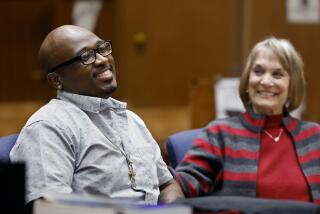Every Court Case Is a Person
IN MARCH, 1981, 19-year-old Fernando Belmontes drove to the San Joaquin Valley home of an acquaintance, Steacy McConnell, hoping to steal her stereo while she was out. Unfortunately, Belmontes had miscalculated and McConnell was home — and in an apparent effort to do away with the only witness to his crime, Belmontes pounded her head 15 to 20 times with an iron dumbbell, crushing her skull.
McConnell’s parents arrived home later to find their 19-year-old daughter dead on the floor in a pool of blood. Meanwhile, Belmontes and two accomplices sold McConnell’s stolen stereo for $100 and bought some beer.
Belmontes was convicted and sentenced to death, but justice moves slowly and he is still waiting in prison for a final determination 25 years later. During those years, his case has wound its way from the California courts to the U.S. Supreme Court, where it is scheduled to be argued next week, on the first full day of the court’s new term.
Ornoski vs. Belmontes is a horror story of punishment and redemption, pitting those who believe that an “eye for an eye” should be the law of the land against those who believe in rehabilitation. But it is only one of many dramatic narratives that will be told and retold in the Supreme Court this year.
Indeed, beneath the cold, impersonal case numbers and the dry, abstruse arguments and the technical points of law, there are endless complex morality plays overflowing with the conflict, passion and suspense of people victimized, and of their victimizers. Stories of murderers and swindlers, of corporate power plays, of police misdeeds and government conspiracies, many filled with pathological and sociological behavior, human suffering and human indifference.
Consider Belmontes. He was brought up in poverty in a home with a violent, alcoholic, perennially out-of-work father who regularly beat his mother — at times so severely that he once broke her arm, and on another occasion stabbed her. He deserted his family when Belmontes was 10. By 15, Belmontes was out of control; by 19, a murderer.
A jury later found Belmontes guilty of first-degree murder with special circumstances — meaning that it could sentence him to death or life in prison without the possibility of parole. But during the sentencing phase of the trial, the judge instructed jury members not to consider evidence suggesting that Belmontes had rehabilitated himself — including the fact that he’d converted to Christianity, been baptized and become a model prisoner and a respected preacher to his fellow inmates.
One of two California Youth Authority chaplains who testified on Belmontes’ behalf, in fact, described him as a “salvageable” person who could make a real contribution to counseling other inmates “because he relate[s] well to other prisoners with similar backgrounds.” Although he believed in the death penalty, the chaplain added, he didn’t want it applied to Belmontes because of “the enormity of the peer pressure and the kind of societal circumstances that were part of his life.”
The jury voted for death. But in 2003, the U.S. 9th Circuit Court of Appeals overturned the sentence on the grounds that the judge had allowed evidence of Belmontes prior criminal history while unfairly eliminating the mitigating evidence of Belmontes’ rehabilitation and his potential to “make positive contributions to the welfare of others if his life was spared” — the crux of the argument on which the Supreme Court is now being asked to rule.
Another California-based case that will be heard this year involves John Cunningham, a former Richmond police officer who was convicted on charges of sexually molesting his 10-year-old son — referred to in court papers as “John Doe.” Cunningham was convicted primarily on the basis of the boy’s testimony. On videotape, Doe described the repeated anal and oral penetrations in nauseating detail, and in a heartbreaking scene, his younger cousin recounted how he had confessed it all to her.
Little physical evidence was apparent when Cunningham’s son was medically examined, and complicating matters further, the boy had previously falsely accused his mother of neglect and his stepfather of beating him.
Nevertheless, young John Doe’s testimony proved so compelling that the jury convicted the father of the charges. The judge sentenced him to the maximum 16 years in prison, tacking on extra time — beyond what he’d normally receive under California’s fixed sentencing guidelines — because of the repeated and violent nature of the acts.
The issue before the Supreme Court now has nothing to do with Cunningham’s guilt or innocence, but is about whether a judge in a jury trial can, in effect, play both judge and jury. If the judge is found to have acted improperly, California’s sentencing laws could be declared unconstitutional.
A third California-based case that will come before the court in the first weeks of the session is Carey vs. Musladin, which, were it not so tragic, would just be bizarre.
In May 1994, Matthew Musladin drove to the home of his estranged wife, Pamela, to pick up their 3-year-old son for a weekend visit. They got into an argument outside, and when Musladin pushed her to the ground, her fiance, Tom Studer, bolted from the house to defend her. Musladin pulled a gun, fired twice at Studer and killed him. Musladin claimed self-defense — saying he believed that Studer had a gun — but he was convicted of murder.
As in Cunningham, the issue before the court is not the crime itself. Rather it is the fact that during Musladin’s 14-day trial, the judge permitted three members of Studer’s family to sit behind the prosecutors’ table wearing buttons prominently displaying pictures of the victim.
A lower court did not think that this was sufficient reason to overturn Musladin’s conviction. But the 9th Circuit ruled in 2005 that the wearing of buttons had raised the possibility of “inherent prejudice” to Musladin’s right to a fair trial. It overturned his conviction.
Supreme Court Justice Oliver Wendell Holmes Jr. once said that “the character of every act depends upon the circumstances in which it is done.” Though the lawyers in the halls and meeting rooms of the Supreme Court this term will no doubt find themselves quickly caught up in the minutiae of the law, in the competing doctrines and arcane legal theories that underpin the vast American justice system, it is worth remembering that behind every case is a story, very often a tragedy, that shouldn’t be forgotten.
More to Read
Start your day right
Sign up for Essential California for news, features and recommendations from the L.A. Times and beyond in your inbox six days a week.
You may occasionally receive promotional content from the Los Angeles Times.






